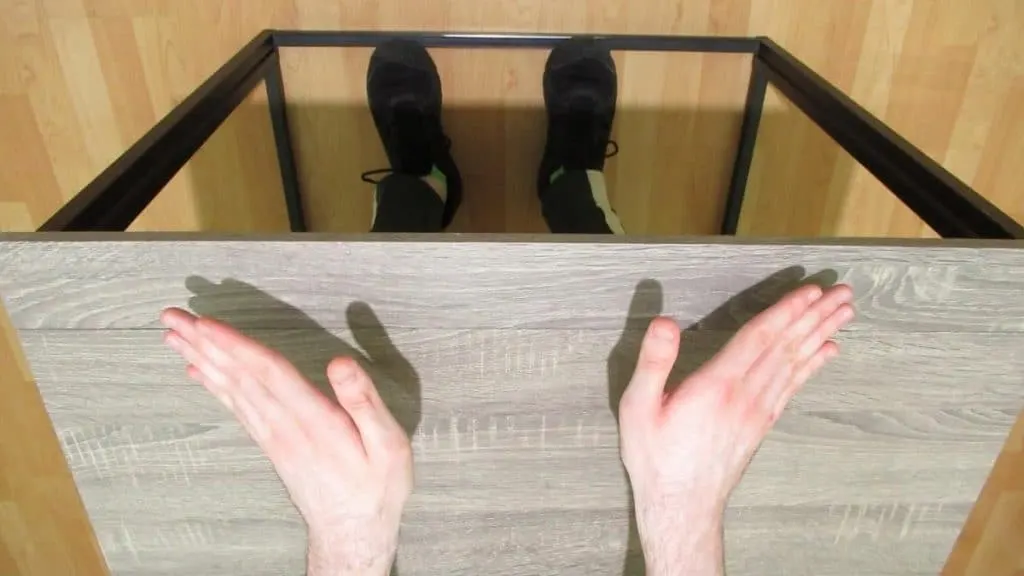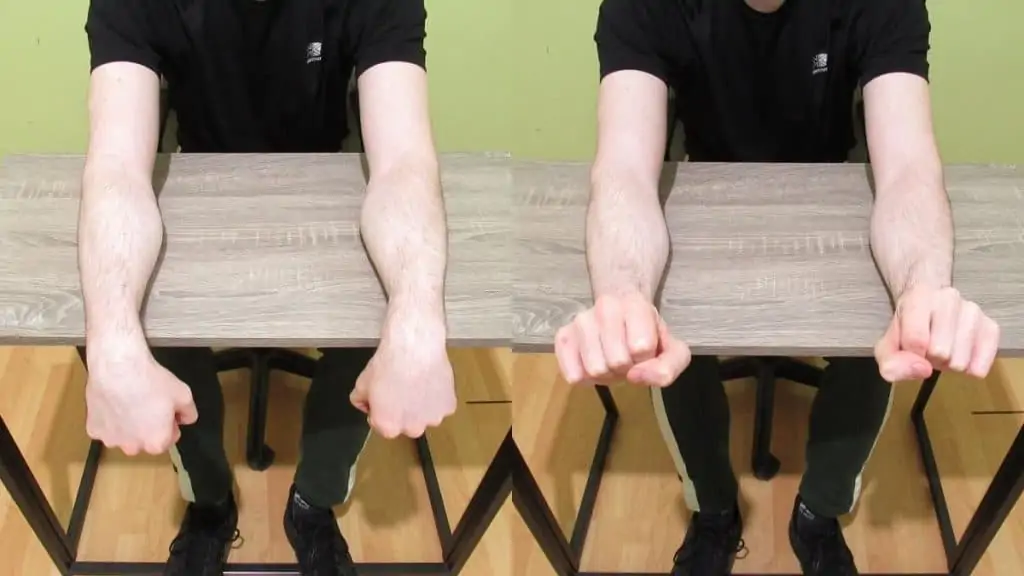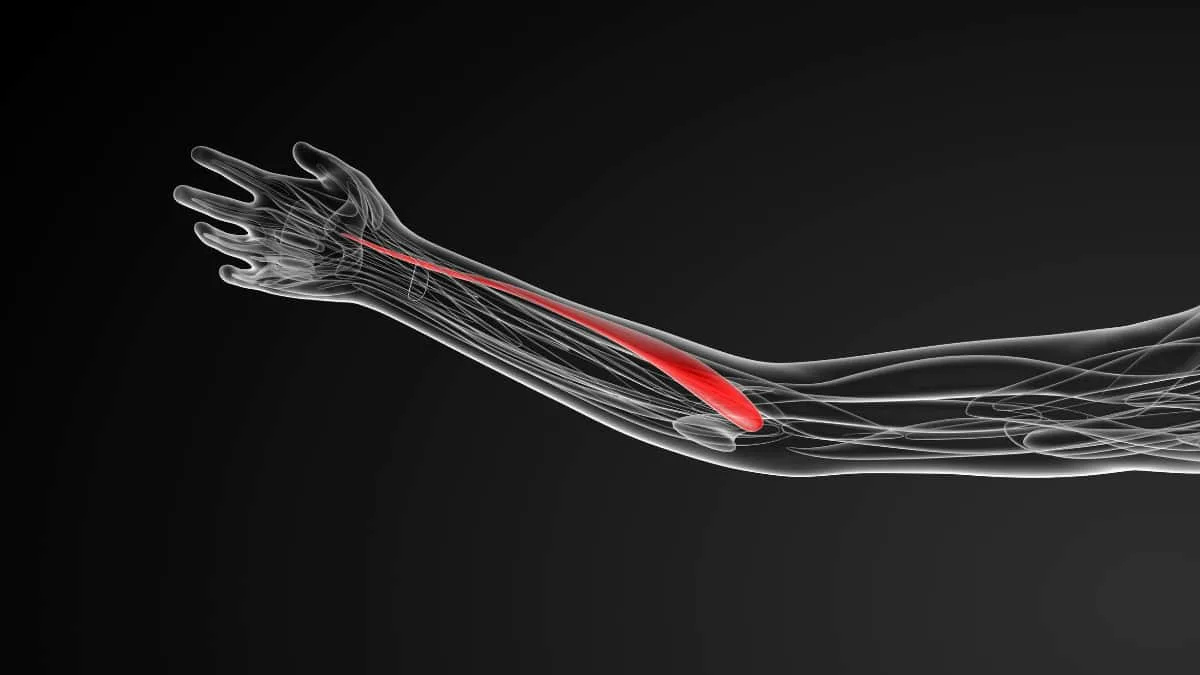Unlike the biceps or triceps, which consist of 2 and 3 muscles, respectively, there are countless forearm muscles that all perform a variety of different functions.
So rather than turn this short article into a university anatomy lesson, I’m going to focus specifically on the extensor carpi radialis longus exercises that you can do for greater forearm health and strength.
Related posts
- Extensor carpi radialis brevis exercises
- Extensor carpi ulnaris exercises
- Extensor digitorum exercises
- Extensor pollicis brevis exercises
Extensor carpi radialis longus facts and figures
The extensor carpi radialis longus is a very long forearm muscle because the forearm bones are also long. [1] But to give the scientific version, the extensor carpi radialis longus is long because it connects to both the lateral part of the humerus, but also to the 2nd metacarpal bone of the hand.
So unsurprisingly, it also performs more than one function. With the help of the neighboring flexor carpi radialis, the extensor carpi radialis longus performs hand abduction (also called radial abduction).
Similarly, it performs wrist extension with the other 5 forearm extensors. In practice, these two anatomical functions help you to grip everyday objects or weights in the gym by allowing your wrist to rotate and extend upwards.
Exercises for the extensor carpi radialis longus
1. Wrist abductions

Since we’re training a very small group of muscles and a particularly delicate joint here, it’s best to do this exercise with no weight at all. This also means that you can perform this drill anywhere because you don’t need access to any special equipment.
Sitting in a chair, place your hand out in front of you and then, using the muscles in your wrist, slowly rotate your hand from side to side. Pause briefly when you abduct your hand all the way to one side so that you can maintain the proper form (you don’t score extra points for doing this exercise quickly).
To make it more challenging, you can add wrist weights. Or, if you don’t have those available, put your wrist into extension and then perform the same rotating motion (aka radial abduction).
You’ll notice that this modification instantly makes the exercise harder. And that’s because your extensor carpi radialis longus is contracted isometrically while you’re performing the exercise in extension. [2]
2. Wrist extensions (bodyweight)

I see so many people (especially meatheads) loading up on wrist extensions and then complaining about wrist pain. That’s like putting your hand in a fire and then complaining that it burns.
Like I said before, the posterior compartment of the forearm is just a collection of really tiny muscles. Some are long and skinny, while others are short and thick. But one thing that they all have in common—including the extensor carpi radialis longus—is their small surface area, which naturally means that they also have a low force output potential (i.e., they’re not very strong).
Therefore, do wrist extensions with the weight of your hands only (see, they’re not completely weightless) before adding external resistance via a dumbbell.
To do the exercise, place your forearms on a desk or table and let your hands hang off the edge. Slowly lower your hands towards the ground until you feel a comfortable stretch in the top of your forearms. Then come straight back until your wrists are slightly hyperextended.
Contrary to some theories, hyperextension is not dangerous when done with proper form, especially with joints like the wrists and hips, which can hyperextend naturally (unlike the knee and elbows, for example).
Coming all the way up also ensures that your extensor carpi radialis longus receives a good contraction, which will help to strengthen it for everyday activities.
3. Reverse curl (bands)

Barbells are known for their muscle-building prowess. Yet they’re equally notorious for causing joint pain—especially during arm exercises.
Therefore, I’m going to recommend bands for this exercise. They’re cheap, you can use them anywhere, and they provide a tremendous muscular contraction.
For this exercise, you’ll want to grab the handles of your resistance bands with a palms-down grip. Then, with your arms tucked into your sides, curl the handles towards your shoulders while keeping your upper arms stationary. This ensures that your forearm extensors—of which the extensor carpi radialis longus is an important member—are doing all of the work.
You want to make sure that you come all the way up, not just to 90-degrees. At the start of the exercise, it’s actually the biceps that are most active. But once you near the top position, the forearms begin to take over, making it a great part of any brachioradialis workout.
And of course, like with any weight lifting exercise, you should lower the handles under control so that you don’t irritate the elbow joint by extending it too forcefully.
Related exercises and stretches
- Anconeus exercises
- Flexor carpi radialis exercises
- Flexor carpi ulnaris tendonitis exercises
- Flexor digitorum profundus stretch
- Flexor digitorum superficialis exercises
- Flexor pollicis longus stretch
- Palmaris longus exercises
- Pronator quadratus exercises
- Pronator teres stretch
Do you need to isolate the extensor carpi radialis longus in order to train it?
The first two exercises that I gave you, while tough on the extensor carpi radialis longus, also work the other muscles of the posterior forearm very well. Actually, the hand abductions also work some of the flexors, but yeah, I know that fact doesn’t help you much practically.
Ultimately, your extensor carpi radialis longus muscles are going to receive plenty of stimulus from regular forearm and grip training. If you don’t want to build particularly muscular forearms but still want them to be strong, then I recommend perfecting the technique of the last 2 exercises with your bodyweight before integrating bands or dumbbells.
The hand abduction exercise you can do with bodyweight only. [3] The point of that drill isn’t to set new one-rep maxes. The aim of the movement is simply to build functional strength in the hands and the surrounding muscles.
Conclusion: What you should know about extensor carpi radialis longus exercises
Stretching and exercising your extensor carpi radialis longus helps your forearms and wrists to stay strong and healthy. This is especially important if you’re losing muscle due to old age or if you are losing grip strength due to inactivity.
That said, there’s no need to fixate on this particular muscle unless you happen to be an undergraduate student who’s studying anatomy and physiology (been there, done that).
Any exercise that uses the forearm extensors will also work the extensor carpi radialis longus nicely.
Of course, you can also try some of the extensor carpi radialis longus exercises that I showed you if you want to take other muscles like the biceps more or less out of the equation.
References
- Rad, A. (2020, October 29). Extensor carpi radialis longus muscle. Kenhub. https://www.kenhub.com/en/library/anatomy/extensor-carpi-radialis-longus-muscle
- Extensor carpi radialis longus. (n.d.). Physiopedia. https://www.physio-pedia.com/Extensor_carpi_radialis_longus
- The Healthline Editorial Team. (2018, January 19). Extensor carpi radialis longus. Healthline. https://www.healthline.com/human-body-maps/extensor-carpi-radialis-longus-muscle

